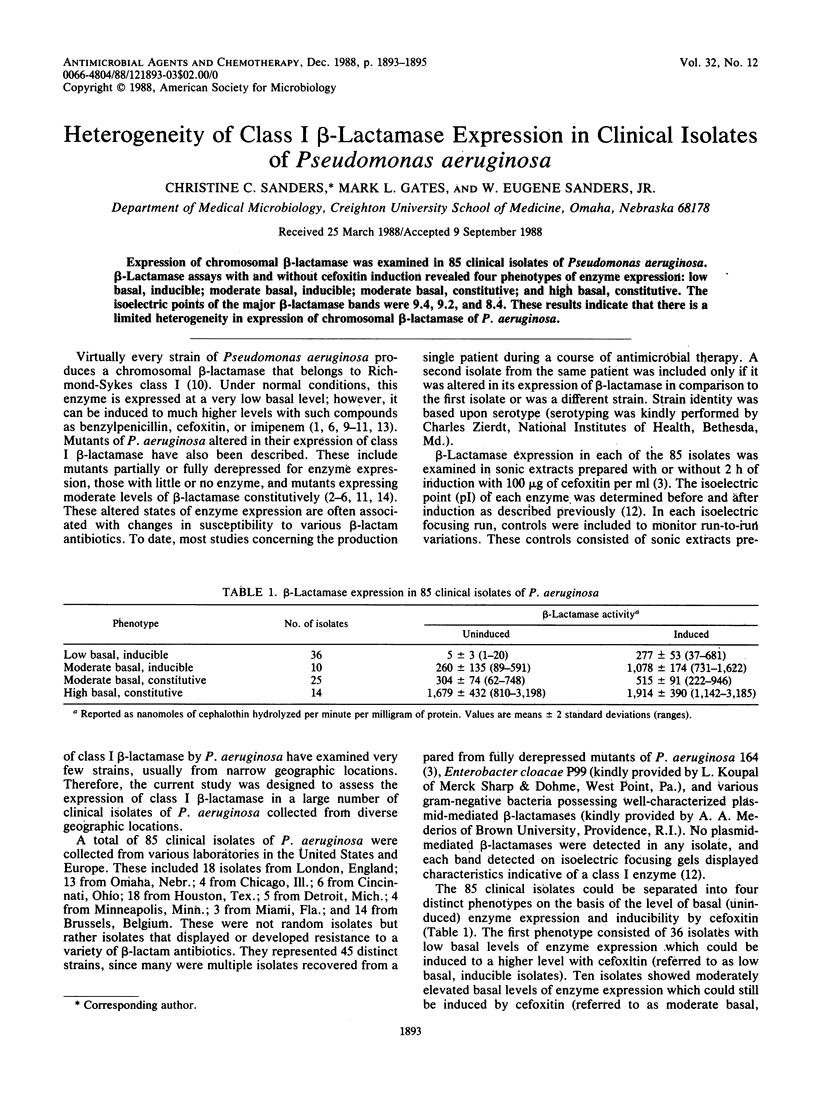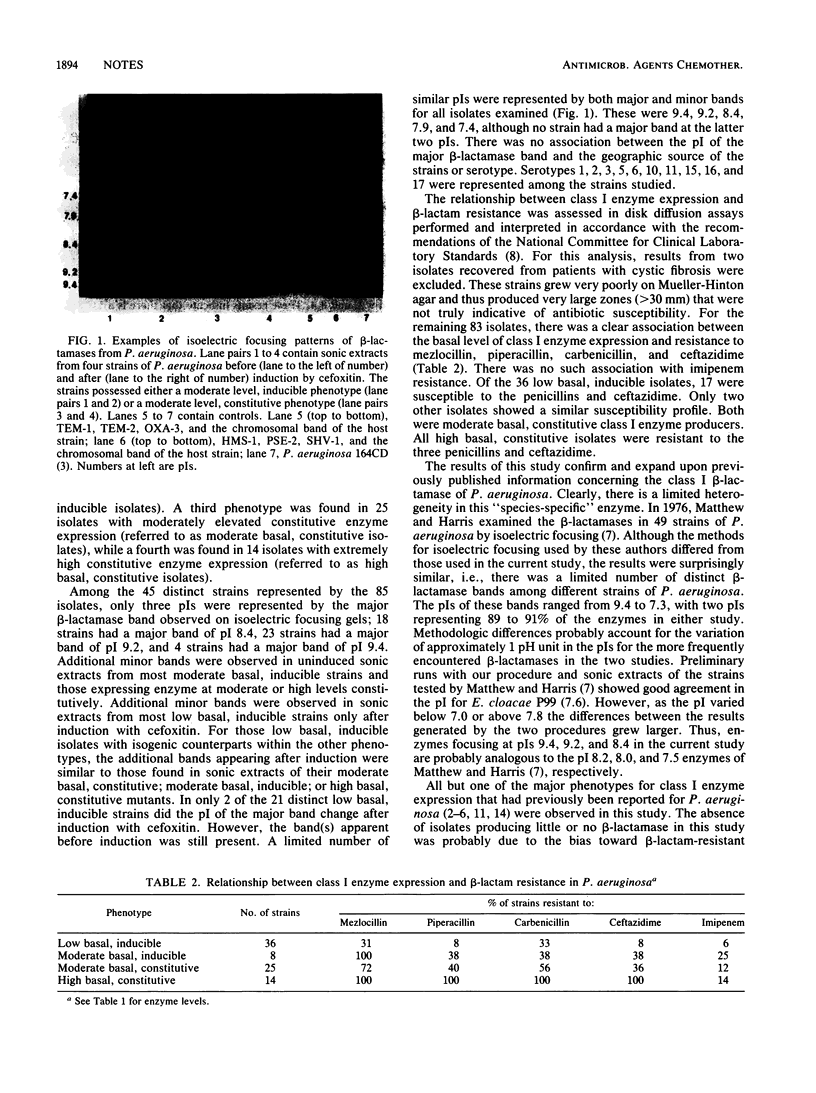Abstract
Expression of chromosomal beta-lactamase was examined in 85 clinical isolates of Pseudomonas aeruginosa. beta-Lactamase assays with and without cefoxitin induction revealed four phenotypes of enzyme expression: low basal, inducible; moderate basal, inducible; moderate basal, constitutive; and high basal, constitutive. The isoelectric points of the major beta-lactamase bands were 9.4, 9.2, and 8.4. These results indicate that there is a limited heterogeneity in expression of chromosomal beta-lactamase of P. aeruginosa.
Full text
PDF


Images in this article
Selected References
These references are in PubMed. This may not be the complete list of references from this article.
- Aronoff S. C., Shlaes D. M. Factors that influence the evolution of beta-lactam resistance in beta-lactamase-inducible strains of Enterobacter cloacae and Pseudomonas aeruginosa. J Infect Dis. 1987 May;155(5):936–941. doi: 10.1093/infdis/155.5.936. [DOI] [PubMed] [Google Scholar]
- Curtis N. A., Eisenstadt R. L., Rudd C., White A. J. Inducible type I beta-lactamases of gram-negative bacteria and resistance to beta-lactam antibiotics. J Antimicrob Chemother. 1986 Jan;17(1):51–61. doi: 10.1093/jac/17.1.51. [DOI] [PubMed] [Google Scholar]
- Gates M. L., Sanders C. C., Goering R. V., Sanders W. E., Jr Evidence for multiple forms of type I chromosomal beta-lactamase in Pseudomonas aeruginosa. Antimicrob Agents Chemother. 1986 Sep;30(3):453–457. doi: 10.1128/aac.30.3.453. [DOI] [PMC free article] [PubMed] [Google Scholar]
- Jacobs J. Y., Livermore D. M., Davy K. W. Pseudomonas aeruginosa beta-lactamase as a defence against azlocillin, mezlocillin and piperacillin. J Antimicrob Chemother. 1984 Sep;14(3):221–229. doi: 10.1093/jac/14.3.221. [DOI] [PubMed] [Google Scholar]
- Livermore D. M., Williams R. J., Lindridge M. A., Slack R. C., Williams J. D. Pseudomonas aeruginosa isolates with modified beta-lactamase inducibility: effects on beta-lactam sensitivity. Lancet. 1982 Jun 26;1(8287):1466–1467. doi: 10.1016/s0140-6736(82)92474-6. [DOI] [PubMed] [Google Scholar]
- Livermore D. M., Yang Y. J. Beta-lactamase lability and inducer power of newer beta-lactam antibiotics in relation to their activity against beta-lactamase-inducibility mutants of Pseudomonas aeruginosa. J Infect Dis. 1987 Apr;155(4):775–782. doi: 10.1093/infdis/155.4.775. [DOI] [PubMed] [Google Scholar]
- Matthew M., Harris A. M. Identification of beta-lactamases by analytical isoelectric focusing: correlation with bacterial taxonomy. J Gen Microbiol. 1976 May;94(1):55–67. doi: 10.1099/00221287-94-1-55. [DOI] [PubMed] [Google Scholar]
- Nordström K., Sykes R. B. Induction kinetics of beta-lactamase biosynthesis in Pseudomonas aeruginosa. Antimicrob Agents Chemother. 1974 Dec;6(6):734–740. doi: 10.1128/aac.6.6.734. [DOI] [PMC free article] [PubMed] [Google Scholar]
- Richmond M. H., Sykes R. B. The beta-lactamases of gram-negative bacteria and their possible physiological role. Adv Microb Physiol. 1973;9:31–88. doi: 10.1016/s0065-2911(08)60376-8. [DOI] [PubMed] [Google Scholar]
- Sanders C. C., Sanders W. E., Jr, Moland E. S. Characterization of beta-lactamases in situ on polyacrylamide gels. Antimicrob Agents Chemother. 1986 Dec;30(6):951–952. doi: 10.1128/aac.30.6.951. [DOI] [PMC free article] [PubMed] [Google Scholar]
- Tausk F., Evans M. E., Patterson L. S., Federspiel C. F., Stratton C. W. Imipenem-induced resistance to antipseudomonal beta-lactams in Pseudomonas aeruginosa. Antimicrob Agents Chemother. 1985 Jul;28(1):41–45. doi: 10.1128/aac.28.1.41. [DOI] [PMC free article] [PubMed] [Google Scholar]
- Zimmermann W. Penetration of beta-lactam antibiotics into their target enzymes in Pseudomonas aeruginosa: comparison of a highly sensitive mutant with its parent strain. Antimicrob Agents Chemother. 1980 Jul;18(1):94–100. doi: 10.1128/aac.18.1.94. [DOI] [PMC free article] [PubMed] [Google Scholar]



